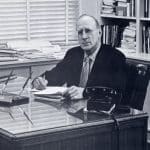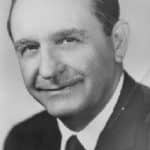(Excerpted from James F. Willis, Southern Arkansas University: The Mulerider School’s Centennial History, 1909-2009, pp. 248-250, 267-268, 283-285)
The president’s [Dr. Imon E. Bruce] efforts to secure funding for the school and to assist its students were as notable as his building program. The task was not an easy one. State funding did not keep pace with rapid enrollment increases. SSC needed more faculty and staff, more equipment, more space, more of everything. The school competed with Arkansas’s other institutions for scarce state dollars. Dr. Bruce was said to have lobbied so vigorously and persistently at the state capitol in Little Rock that officials sometimes gave him money just to get rid of him. The president essentially served as his own finance administrator but was ably assisted by Robert “Bob” H. Cole Jr. who directed the school’s business office.
New sources of money from the federal government helped. Such aid included the National Defense Education Act of 1958 for student loans and the Higher Education Facilities Act of 1963 for construction. President Lyndon B. Johnson’s Great Society legislation of the mid-1960s provided funding on an unprecedented scale with the Higher Education Act of 1965. It provided college work-study funds to employ students and grants to low-income students, later named Pell Grants for their Senate champion. Finally, other laws guaranteed student loans from private lenders. Numerous “titles” of the 1965 law provided funds for other needs. To handle the new programs, Dr. Bruce increased the administrative staff. Dr. Charles W. Jackson, formerly a superintendent of schools at Swifton, Arkansas, was hired in 1965 as assistant to the president for federal programs, and Bernard H. Polk, a retired civil servant and former classmate of Dr. Bruce at Magnolia A&M, became the financial aid director in 1966.
From the school’s beginning in 1911, a tradition had been followed, as Dean Milton Talley put it, “to never let a student leave school for financial reasons if he is passing his work, has the right attitude, and is not on social or disciplinary probation.” Federal aid made it easier to assist more students. A smaller program—referred to as regular work—came entirely from SSC funds for students not qualifying for federal work-study. By 1969–70, as federal aid increased, almost 46 percent of full-time students received aid in grants, work-study, or guaranteed low-interest loans. Some 800 worked on campus while 398 received grants. The average student received $707 per year (whites $677 and blacks $823) at a time when tuition and room and board for a year averaged $950.
One federal aid program—Upward Bound—encouraged high school students from families of limited means to attend college. Beginning in 1965–66, some seventy to eighty students were brought to campus several times each year and each summer for an eight-week residence. Dr. Charles Jackson served as the first director of Upward Bound, soon followed by Dr. Ann K. Thomas. Upward Bound succeeded, for more than 50 percent of its students did later enroll at SSC or at other colleges.
Most of SSC’s funding continued to come from Arkansas’s government. The recently established Commission on the Coordination of Higher Education (CCHEF), however, proved as much an obstruction as an aid to getting a fair share of state funding. Dr. Bruce became the target of its first director’s “aggressive and authoritarian management style” after he challenged E. L. Angell’s 1965–67 budget recommendation to the legislature. Angell failed to take into account SSC’s rapid enrollment increases. As a result, SSC’s state appropriation was the lowest amount per student of all state-supported colleges—$509 per student, approximately $100 less than the other colleges. This disparity continued, and the state’s contribution to SSC’s total income fell from 44 percent in 1962 to 39 percent by 1969.
When [Arkansas Governor] Orval Faubus retired in January 1967 after twelve years as governor, his successor, Winthrop Rockefeller, elected in 1966, was the first Republican governor of the state in a century. Partisan Democratic legislators refused to pass his ambitious reform program in 1967. Colleges and the university benefited from this partisanship. The Legislative Council in an unusual action adopted without change CCHEF’s budget recommendations, contrary to the governor’s wishes. In the end, SSC received only 70 percent of a $1,604,590 appropriation. Still, that was 40 percent more than the college had actually received in the previous biennium’s first year when revenue stabilization procedures required budget cuts to match revenues.
· · · · · · · ·

Walter Frank Tate, SSC student whose accidental death led to first donation to college endowment for scholarships (Click photo to enlarge)
Dr. Bruce recognized, as did most college presidents at the time, that the uncertainties of state funding required more reliance on private sources. He persuaded the alumni association to vote on November 8, 1963, to establish an endowment although its legal documents were not filed until 1967. Remarkably, the first contribution to the endowment was a $578 life insurance payment from the estate of SSC senior Walter Tate of Camden. He had thoughtfully named his alma mater as beneficiary. In a tragic automobile accident, he died just before graduating. Tate was the grandson of (Walter) Frank Tate, the Farmers Union leader who had helped found the school and served on its original board of trustees. The endowment’s first scholarship, named for Magnolia A&M Dean M. O. Alcorn and contributed by his children, was awarded in 1968. Dr. Bruce secured the fund-raising assistance of retired coach Elmer Smith who became a part-time assistant to the president for development in 1973. By the time Dr. Bruce retired in 1976, the endowment total stood at $678, 181.59.
· · · · · · · ·
Over fifteen years, Dr. Bruce had essentially built a new campus to replace the one he had attended forty-five years earlier. In the process, he increased SSC’s bonded indebtedness from $2 to $6 million, and debt retirement in the 1970s required an expenditure of $400,000 per year. Even Dr. Bruce’s unmatched mastery of finances was tested, as he continued to build, in the midst of the downturn beginning in 1969–70. The year-by-year decline of students and consequent loss of tuition and room payments reduced income required to retire the bonds. The president told the faculty in March 1970 that for the first time since 1959 SSC had a budget deficit and had to dip into reserve funds. For the next several years, “economize, economize” became the mantra. Budgets were trimmed in every category except salaries. Dr. Bruce gradually reduced faculty through retirements and voluntary departures. Few faculty were dismissed or departments eliminated for economic reasons. Geography was the exception. Several fields in which students had been able to major were reduced to minors.
An increasing economic problem was inflation. The dollar lost value beginning in 1965. By 1976, when Dr. Bruce retired, it took $180 to buy the same products or services that had cost $100 a decade earlier. On the other hand, as enrollment decreased, SSC’s state budget was not reduced proportionately; therefore, the earlier disparity in funding per student disappeared. As tuition income declined, the percent of the state’s contribution to the school’s budget rose again.
Governor Dale Bumpers’s tax increases helped relieve SSC’s economic stress, especially during his second term, 1973–75; but he had resisted pressure for much greater higher education expenditures in his first term. Bumpers, a Democrat, was able to guide through the legislature a reform program, largely proposed by his predecessor, Republican governor Winthrop Rockefeller. This included the largest tax increase in state history in 1971. Even this massive tax increase would not immediately fill the state’s coffers. Bumpers had two answers to college needs in 1971: “creative retrenchment” and increased tuition. He declared colleges should eliminate duplicating programs, pointedly declaring that the state did not need five colleges offering agricultural degrees when so few citizens were still farmers. Bumpers demanded that all four-year state-supported institutions raise tuition at least $100 ($50 each semester). When the 1971 legislative session ended, Dr. Bruce would say, “Our financial problems have increased.” SSC had to raise its tuition $150 ($75 each semester) to $400 a year. Financial problems pushed two other small colleges in South Arkansas—Arkansas A&M at Monticello and Arkansas AM&N at Pine Bluff—to merge with the University of Arkansas in 1971. In two years, the university system had increased from one campus to four.
Supporters of SSC and the other small state colleges worried that some legislators wanted to merge all state colleges into one university system. Grateful for the new taxes, they were not as resistant to Act 38 (1971) as they might have otherwise been. With this law, Governor Bumpers achieved a major government reorganization that included turning CCHEF into the Department of Higher Education (DHE) as part of his new cabinet. DHE had slightly increased powers to review programs as well as coordinate budgets. The legislature directed DHE to conduct role and scope studies of each institution and report to the 1973 session. A program review recommended deletion of ten SSC programs. Due to Arkansas’s constitutional Amendment 33, the autonomy of college boards remained an obstacle to DHE’s powers. SSC’s board rejected DHE’s recommendations and eliminated only two programs—French and industrial distributive education. Governor Bumpers’s financial largesse to the state colleges and universities came at an additional cost, one that Dr. Bruce vigorously opposed. That was the expansion of the state’s community junior college system.







